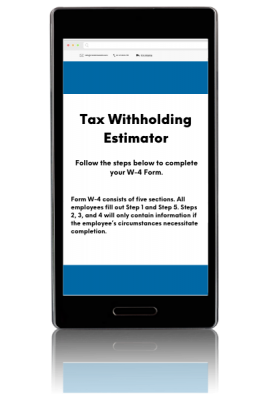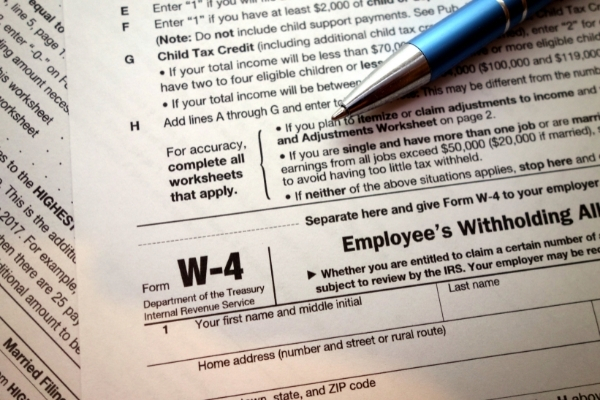Filling out W-4s: What employers and employees need to know.
Anyone starting a new job must fill out Form W-4: Employee’s Withholding Certificate. Employers use the information provided on this Internal Revenue Service document to determine the amount of tax to withhold from an individual’s wages each paycheck. On behalf of the employee, the employer gives these income tax withholdings to the government on a regularly-scheduled basis to cover tax liability. The total amount withheld for the year appears on the employee’s W-2 form. An accurate W-2 is vital for completing a personal annual federal income tax return.
Whether you’re a small business or a large one, the IRS requires that you ask new employees to fill out Form W-4. As an employer, you must make appropriate paycheck deductions based on the information provided and pay withholdings to the IRS on time. The IRS also requires recordkeeping. It asks companies to hold on to a copy of the employee’s withholding certificate for at least four years.
The actual act of filling out a W-4, however, falls to the individual employee. Each person must examine his own circumstances when filling out a W-4 and realize his accountability for information entered. He may want to consult a tax advisor for advice prior to completing this important tax form.
The IRS encourages people filling out W-4 to do so as accurately as possible. Its goal is zero tax liability for both the government and the individual taxpayer on the yearly personal federal tax return. Simply put, the IRS sees the ideal situation come tax season as it not needing to issue a tax refund and the citizen not owing money.
Creating this successful scenario starts with the employee filling out W-4 so that the employer can take out the proper amount of tax withholding. Encourage new hires to do a thoughtful step-by-step read-through of this tax form’s various sections.
Filling out your W-4 sections step-by-step
Form W-4 consists of five sections. All employees fill out Step 1 and Step 5. Steps 2, 3, and 4 will only contain information if the employee’s circumstances necessitate completion.
IRS Form W-4: Step 1
This step collects personal information. The employee should enter their name, address, and social security number. An employer should verify that these items match what the organization has on file. Typos and misspellings can cause havoc down the line.
Line C of Step 1 asks for filing status. The employee should check one of the boxes from the choices: single or married filing separately; married filing jointly or qualifying widow(er); or head of household. Correct filing status determines the standard deduction and tax rates used to compute withholding.
Many employees will be able to skip ahead to Step 5 after this basic section. Before doing so, however, they should glance at Steps 2, 3, and 4 to see if any apply to them.
IRS Form W-4: Step 2
The header for this section reads “Multiple Jobs or Spouse Works.” Employees who have more than one job should fill it out. Ditto if a spouse works and the couple files a joint tax return. The correct amount of withholding depends on income earned from all of these jobs.
Completers of Step 2 will do one of three things: Use the app known as the IRS’s tax withholding estimator, use the Multiple Jobs Worksheet included with the W-4, or check a box that tells the IRS there are only two jobs total and they are both of similar pay. For this last option, the filled out W-4 for the other job (either the employee’s other position or a spouse’s job) should likewise have this box checked.
IRS Form W-4: Step 3
Prior to continuing, W-4 instructions tell people who completed Section 2: Multiple Jobs or Spouse Works to “Complete Steps 3-4(b) on Form W-4 for only ONE of these jobs. Leave those steps blank for the other jobs. (Your withholding will be most accurate if you complete Steps 3-4(b) on the Form W-4 for the highest paying job.)”
Step 3 deals with dependents and pertains to individuals with a total income of $200,000 or less or married couples filing jointly who earn $400,000 or less. It requires multiplying the number of qualifying children under age 17 by $2,000 and multiplying the number of other dependents by $500. IRS Publication 972: Child Tax Credit and Credit for Other Dependents proves useful to people trying to determine if their child or another relative meets eligibility requirements.
Remember that the IRS’s objective is for taxpayers to neither owe nor receive money when they fill out annual federal income tax returns. Factoring in the child tax credit on the W-4 increases one’s paycheck by reducing the amount of tax the employer withholds. More money in one’s wallet can prove helpful for covering living expenses, paying off credit card debt, financing education, investing, and the like. However, realize that this “extra now” reduces the amount of tax refund come tax season.
IRS Form W-4: Step 4
Step 4 is called “(optional) Other Adjustments.” It provides a place for the employee to input other things that affect his withholding, if he so chooses.
On line A, employees can report additional income. Note that this is additional income from sources other than jobs. Job-related adjustments, including projected self-employment income, get handled in Step 2.
People often choose to complete Step 4 Line A as an alternative to making estimated tax payments on their own. Unlike wages from an employer, money gained from some sources (perhaps interest, dividends, or retirement income) may not automatically have tax withheld. The recipient, however, still is responsible for tax obligations on the sum. By figuring the other income into what comes out of a paycheck, the person can avoid filling out 1040-ES paperwork and making estimated payments on his own.
Someone expecting to claim deductions other than the standard deduction can use Step 4 Line B to reduce withholding. Such itemized deductions may include qualifying home mortgage interest, charitable contributions, state and local taxes, and medical expenses in excess of 7.5% of your income. Student loan interest and deductible IRA contributions also may influence the result. The Deductions Worksheet included with the W-4 walks people through the process.
If a person wants any additional tax withheld during each pay period, she can use Step 4 Line C to make the request for extra withholding. Someone may choose this voluntary reduction in order to receive a larger refund or reduce the amount of tax she expects to owe on her federal tax return. The reason is not important to the employer. Payroll just needs to withhold this additional amount.
IRS Form W-4: Step 5
The employee must sign and date where indicated in Step 5. The signature attests “Under penalties of perjury, I declare that this certificate, to the best of my knowledge and belief, is true, correct, and complete.”
The other part of Step 5 is for the employer to fill out. It asks for employer’s name and address, first date of employment, and employer identification number (EIN).
Exempt employees filling out W-4
Sometimes, employees believe they are exempt from W-4 filing and do not require tax money to be taken out of their paycheck. Determining exemption status is the employee’s responsibility, including paying any penalty later if the IRS deems the person should not have made that exemption claim.
An HR rep may want to strongly suggest the employee in question consult IRS guidelines before claiming exemption. The IRS has specific criteria, and the person needs to decide for himself if he meets them.
From an employer’s perspective, the important thing here is still to collect the Form W-4. An exempt employee should fill out name, address, and social security number in Step 1. Then, he should write “Exempt” in the space below line C in Step 4 to certify that he meets exemption conditions. Lastly, he needs to sign and date in Step 5.
Both employer and employee also should be aware that a W-4 claiming exemption from withholding is valid for only the calendar year in which it is furnished. The employee must submit a new Form W-4 each year to continue claiming exemption. The due date for this submission is February 15. If the employee fails to resubmit, payroll should withhold tax as if the person is single with no other adjustments. Or, if HR has a valid earlier Form W-4 (one not claiming exempt status) on record, the company can withhold as it did before on that version.
Filling out Form W-4 again to update tax withholding
The IRS issued a new W-4 form in 2020. This action caused some confusion about whether or not employees who already had one on file needed to complete the W-4 again.
While HR gives the new W-4 to all who start a new job, existing workers do not need to submit a new form. However, any time an existing employee wants to make withholding changes, provide the updated version of Form W-4.
Since life changes and financial situation changes often affect tax withholding, encourage all employees to do a “paycheck check-up” from time to time. Good promotion opportunities include the end of the year when the tax year ends in December and around April 15 when taxpayers often discover an unanticipated tax bill.
An up-to-date W-4 ensures what payroll takes out of an employee’s paycheck best reflects his current circumstances. People sometimes do not realize the multitude of life changes that impact their tax withholdings. Common scenarios include taking on a second job or gig work, a spouse returning to work or no longer being employed, changing marital status, having or adopting a child, or adding or losing dependents.
While some re-evaluating their tax withholding may want to read W-4 instructions and use its worksheets, others find the IRS’s Tax Withholding Estimator convenient. This free online tool gives withholding recommendations based on information put in by the employee. It does not ask for identifiers such as name or social security number, and it does not save.
Filling out state W-4 forms for accurate withholding
All U.S. employees fill out a federal W-4 when they start a new job. The form determines the amount of money to take out of the person’s paycheck to meet his federal tax obligation. Most individual states also collect state income tax. Some states let employers use the information from the federal W-4 to calculate what to withhold for state taxes. Others require different paperwork specific to their state. Employers and employees should be aware of what is done in their state to maintain compliance and ensure no surprises on their state tax return come tax season.






